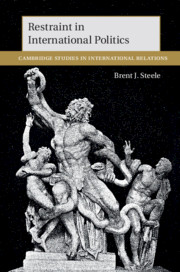Book contents
- Restraint in International Politics
- Cambridge Studies in International Relations: 151
- Restraint in International Politics
- Copyright page
- Dedication
- Contents
- Figures and Tables
- Acknowledgments
- Introduction
- 1 Restraint Appraised
- 2 Restraint and Actionism in Global Politics
- 3 The Historical (Ab)uses of Restraint
- 4 Democratic Restraint, Democratic Libido
- 5 Restraint, Anti-Climax, and Insecurity
- 6 Restraining Those Who Can’t Restrain Themselves
- Conclusion: Towards a Strategic Narrative of Restraint
- References
- Index
- Cambridge Studies in International Relations
3 - The Historical (Ab)uses of Restraint
Gender, Race, and Class
Published online by Cambridge University Press: 25 October 2019
- Restraint in International Politics
- Cambridge Studies in International Relations: 151
- Restraint in International Politics
- Copyright page
- Dedication
- Contents
- Figures and Tables
- Acknowledgments
- Introduction
- 1 Restraint Appraised
- 2 Restraint and Actionism in Global Politics
- 3 The Historical (Ab)uses of Restraint
- 4 Democratic Restraint, Democratic Libido
- 5 Restraint, Anti-Climax, and Insecurity
- 6 Restraining Those Who Can’t Restrain Themselves
- Conclusion: Towards a Strategic Narrative of Restraint
- References
- Index
- Cambridge Studies in International Relations
Summary
This chapter reviews the historical asymmetric application of restraint across groups based on race, gender, and class. It revisits Elias's Established/Outsider dynamic that illustrates these tensions, as well as the historiographic works of Historical IR scholars regarding the dynamic as it played out in the emerging field of International Relations.
Keywords
- Type
- Chapter
- Information
- Restraint in International Politics , pp. 92 - 123Publisher: Cambridge University PressPrint publication year: 2019

